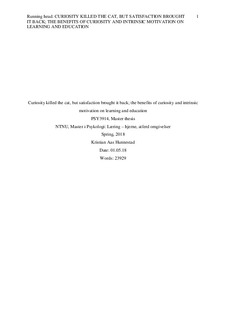| dc.description.abstract | Curiosity is a debatable subject as researchers of the last century have not agreed on taxonomy, arguing from everything between drive theories to cognitive theories. Though the arousal of curiosity is not properly understood yet, measurable frameworks have been developed and this article will browse into Self Determination Theory, drive theories, and cognitive theories in an attempt to understand curiosity and intrinsic motivation’s effect on learning, or perceived competence. Research from the last decade indicate significant correlations between curiosity and intrinsic motivation, curiosity and learning, and intrinsic motivation and learning, yet causality is still a vital problem in fully understanding curiosity. This study examined the variables of curiosity, intrinsic motivation, self-regulation and learning, as well as their underlying facets; and found several significant correlations indicating a relationship between curiosity, intrinsic motivation, and learning. Upon testing for causality between groups, no results were found due to a violation of sphericity. The paper continues to assess the limitations of the study, mainly a minimal sample size, and the possible validity of trait curiosity theories. Concluding, more research is needed to judge whether curiosity can be considered a trait or state. | nb_NO |
